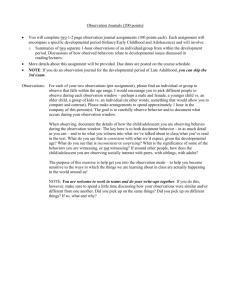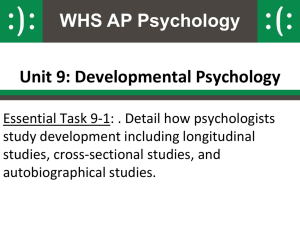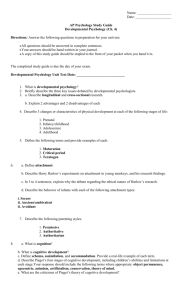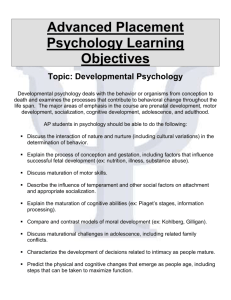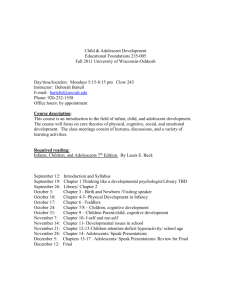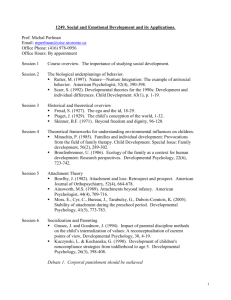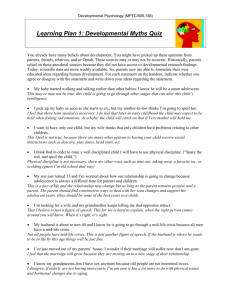Human Development - The Gevirtz School (GGSE)
advertisement
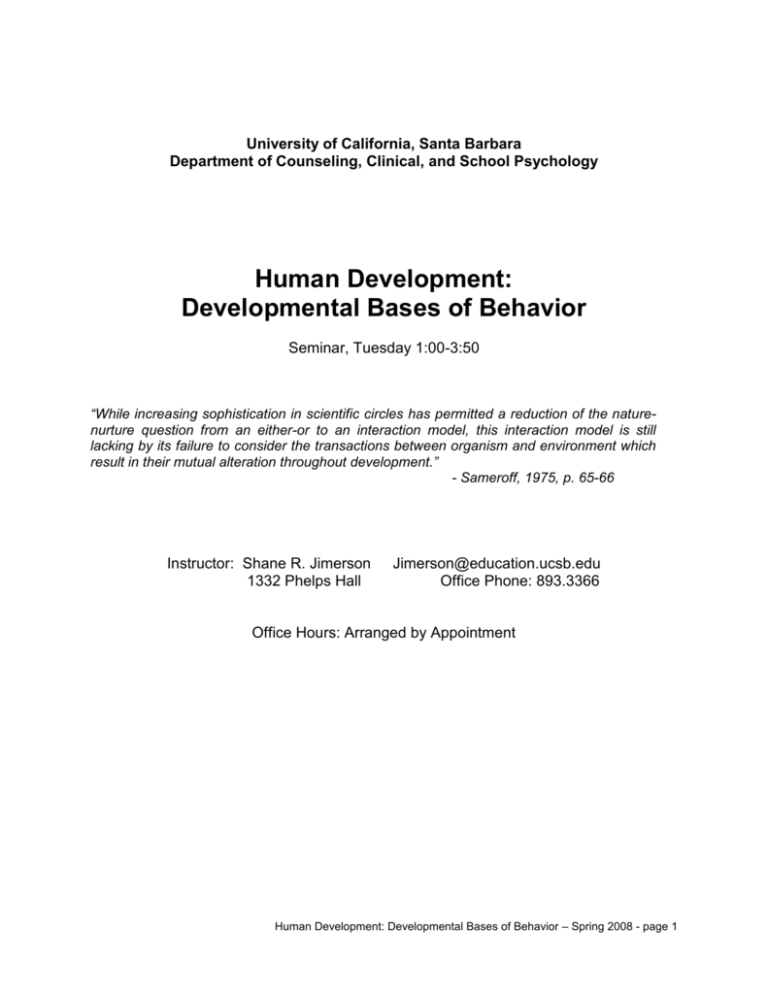
University of California, Santa Barbara Department of Counseling, Clinical, and School Psychology Human Development: Developmental Bases of Behavior Seminar, Tuesday 1:00-3:50 “While increasing sophistication in scientific circles has permitted a reduction of the naturenurture question from an either-or to an interaction model, this interaction model is still lacking by its failure to consider the transactions between organism and environment which result in their mutual alteration throughout development.” - Sameroff, 1975, p. 65-66 Instructor: Shane R. Jimerson 1332 Phelps Hall Jimerson@education.ucsb.edu Office Phone: 893.3366 Office Hours: Arranged by Appointment Human Development: Developmental Bases of Behavior – Spring 2008 - page 1 Human Development: Developmental Bases of Behavior Course Overview This course is devoted to understanding the social bases of behavior. There are two central intertwined themes: theory and research regarding processes and dimensions of developmental bases of behavior (e.g., the self, aggression, gender roles). Special attention will be given to considering theories of human development and their significance for scholarship and professional activities in applied psychology. Developmental psychology is the scientific study of progressive psychological changes that occur in human beings as they age. Developmental psychology informs our understanding of how people come to perceive, understand, and act within the world and how these processes change as they age. Broadly, this course is designed to help students think critically and creatively about developmental bases of behavior. The organization and course requirements outlined below provide the scaffolding to accomplish the above goals. Organization of the course This course will be organized to focus on topics within human development. Each graduate student in the course will select a week (theorist) to focus on during quarter. The graduate student will present on that theorist during the specified session AND be responsible for representing that theorist’s perspective throughout the course in all class discussions (if the number of seminar participants requires it, then pairs of students will complete the activities delineated below). Each week, the primary readings will include one paper/chapter representing a major theorist in that topic area of development AND papers/chapters which represent seminal and/or recent research related to the area of development and hopefully an extension of the theorist being discussed. Course Requirements I. Class Presentation Each student will select a theorist during week one (be certain to sign up for a theorist during week one). The class presentation must include: A. B. C. D. a review of the historical influences on the individual (the zeitgeist), an overview of the individual’s ideas/theory, how the individual has influenced the field and scholarship, identify recent research reflecting the influence of this individual (describe 3 recent studies that are exemplars), E. delineate implications for scholarship and practice of applied psychology, and F. outline key points to remember about that individual’s ideas regarding development. Human Development: Developmental Bases of Behavior – Spring 2008 - page 2 Experience has demonstrated that obtaining a copy of a vita for those who are alive is very helpful in providing perspective on the individual’s career. The presentation must include an outline distributed to each course participant and should be approximately 60 minutes in duration. Please be certain to e-mail your powerpoint presentation to the professor in advance, and also bring a jump drive with the file on it to be certain that there is a functional copy of your powerpoint presentation for the session. Also, prepare a handout (no more than 2 pages) that provides a brief summary of key information that is included in your presentation (and bring a copy for each seminar participant). The class presentation will be made on the date scheduled in the syllabus for discussion of the chosen theorist. For each presentation feedback will be provided by both peers and the seminar professor, using the review form in this syllabus. II. Class Participation Each student will identify a theorist to focus on during week one. Throughout the course, each student is responsible for representing the ideas of the chosen theorist. During course discussions each student will share thoughts regarding the topic of the week, considering the ideas of the chosen theorist. Each week it is essential that each student prepare several comments and thoughts on each of the readings, this will contribute greatly to the discussion. III. Term Paper A term paper (10 pages total, double spaced) will be required of all students. As specified above each student will select a theorist important in the field of social development. This term paper will include the information prepared for the class presentation. The paper must also include a special emphasis on current research regarding social development which incorporates the ideas of the chosen theorist. All papers must be in APA format, double spaced, 1 inch margins, 12 pt times font and one printed copy will be due at the tenth class meeting. IV. Article Recommendation The article recommendation is to focus on the topic of your class presentation and suggest which articles you would keep in the Required Readings and which you would delete-- with a brief (no more than 1 page total) rationale for or against each current reading. In addition, each student MUST identify, and submit a clean and complete single-sided copy of, one recent article/chapter they would recommend as an addition or supplement to the current Required Readings. Each student is required to provide a brief explanation as to why they would recommend the particular reading and how/why it replaces or supplements each of the current readings. It is essential that you include the full APA style citation written on the article/chapter that you submit. This written project will be due at the tenth class meeting. Human Development: Developmental Bases of Behavior – Spring 2008 - page 3 Review and Feedback Form for In-Class Presentation Assignment Topic____________________ Date_______ 1 = poor 3 = average 5 = excellent 1. The presentation addressed each of the assigned areas (a-f): 1 2 3 4 5 Feedback: 2. The organization of the presentation (including duration): 1 2 3 4 5 Feedback: 3. The quality of the summary of 3 recent relevant studies: 1 2 3 4 5 Feedback: 4. The quality of the handout for the presentation: 1 2 3 4 5 Feedback: 5. The effectiveness of the presentation in facilitating learning: 1 2 3 4 5 Feedback: 6. The overall quality of the presentation: 1 2 3 4 Feedback: 5 Overall Score ___________ (out of 30) Other Suggestions, Questions, Comments, Praise… Human Development: Developmental Bases of Behavior – Spring 2008 - page 4 Grading Procedures Students must complete all of the above requirements. The class presentation, class participation, and term paper are each worth 30 points. The article recommendation is worth 10 points. Thus, there are 100 points. (A range >=90% of total points > B range >=80% of total points we’ll talk <=79% of total points) Important Policies • Late assignments will not be accepted and in-class activities cannot be made up at a later date. If you must miss a session, make arrangements prior to your absence to fulfill the assignment. • Any form of Scholastic Dishonesty will result in an F and an official notification to the CLA Scholastic Conduct Committee and the Dean of Academic Affairs. Scholastic Dishonesty includes (but is not limited to); cheating on assignments or exams; plagiarizing (misrepresenting as one's own anything done by another); depriving another student of necessary course materials; or sabotaging another's work. • Students with documented disabilities are invited to contact me to discuss special arrangements that may be needed to facilitate successful completion of the course. I will arrange appropriate accommodations. Required Readings Packet of selected Journal Articles and Book Chapters available from The Alternative Copy Shop, 6556 Pardall Road, Isla Vista, (968.1055). Human Development: Developmental Bases of Behavior – Spring 2008 - page 5 Social and Developmental Bases of Behavior Weekly Topics Week Topic Readings 1. Introduction / Overview Sameroff (1975) Waters & Sroufe (1983) 2. Cognitive Facets and Impression Formation Piaget & Inhelder (1969) Crick & Dodge (1994) 3. Early Relationships Bowlby (1982) Bretherton (1992) Sroufe (1983) 4. Family, Ecological, and Contextual Bronfenbrenner (1986) Darling & Steinberg (1993) Maccoby (1992) 5. Friendships and Peers Dishion, Patterson, & Griesler (1994) Hartup (1998) Krappman (1996) 6. Self, Identity, and Autonomy Erickson (1968) Harter (1990) Roberts et al. (1999) 7. Romantic and Close Relationships Collins & Sroufe (1999) Fitness, Fletcher, & Overall (2005) Furman & Wehner (1997) 8. Aggression Anderson & Huesmann (2005) Bandura (2001) Bandura, Ross, & Ross (1961) 9. Gender Roles Bem (1981) Maccoby (1990) Concluding Comments Felner & Felner (1989) Sameroff & Fiese (2000) Sameroff, et al., (1998) 10. Human Development: Developmental Bases of Behavior – Spring 2008 - page 6 References week 1 Sameroff, A. (1975). Transactional models in early social relations. Human Development, 18, 6579. Waters, E. & Sroufe, L. A. (1983). Social competence as a developmental Construct. Developmental Review, 3, 79-97. week 2 Piaget, J. & Inhelder, B. (1969). The psychology of the child. NY: Basic Books, Incorporated. Crick, N. & Dodge, K. (1994). A review and reformulation of social-information-processing mechanisms in children’s social adjustment. Psychological Bulletin, 115, 74-101. week 3 Bowlby, J. (1982). Attachment: Attachment and Loss (Volume 1). NY: Basic Books Incorporated. Bretherton, I. (1992). The origins of attachment theory: John Bowlby and Mary Ainsworth. Developmental Psychology, 28, 759-775. Sroufe, L. A. (1983). Infant-caregiver attachment and patterns of adaptation in preschool: The roots of maladaptation and competence. In M. Perlmutter (Ed.), Development and Policy Concerning Children with Special Needs, The Minnesota Symposia on Child Psychology, 16 (pp. 41-79). Hillsdale, NJ: Lawrence Erlbaum Associates. week 4 Bronfenbrenner, U. (1986). Ecology of the family as a context for human development: Research Perspectives. Developmental Psychology, 22 (6), 723-742. Darling, N., & Steinberg, L. (1993). Parenting style as context: An integrative model. Psychological Bulletin, 113 (3), 487-496. Maccoby, E. (1992). The role of parents in the socialization of children: An historical overview. Developmental Psychology, 28 (6), 106-117. week 5 Hartup, W. (1992). Friendships and their developmental significance. In H. McGurk (Ed.), Childhood Social Development: Contemporary Perspectives. London: Routledge. Dishion, T., Patterson, G., & Griesler, P. (1994). Peer adaptations in the development of antisocial behavior: A confluence model. In L. R. Huesmann, Aggressive Behavior: Current Perspectives. NY: Plenum Press. Krappmann, L. (1996). Amicita, drujba, shin-yu, philia, freundschaft, friendship: On the cultural diversity of a human relationship (pp. 19-40) . In W. M. Bukowski, A. F. Newcomb, & W. W. Hartup, Human Development: Developmental Bases of Behavior – Spring 2008 - page 7 (Eds.), In the company they keep: Friendship in childhood and adolescence (pp. 19-40). NY: Cambridge University Press. week 6 Erikson, E. (1968). Identity: Youth in crisis. NY: W. W. Norton. Roberts, R., Phinney, J., Masse, L., Chen, Y., Roberts, C., & Romero, A. (1999). The structure of ethnic identity of young adolescents from diverse ethnocultural groups. Journal of Early Adolescence, 19, 301-322. Marcia, J. (1993). Ego identity: A handbook for psychosocial research. NY: Springer-Verlag week 7 Collins, W. A. & Sroufe, L. A. (1999). Capacity for intimate relationships: A developmental construction. In W. Furman, B. B. Brown, & C. Feiring (Eds.), Contemporary perspectives in adolescent romantic relationships. New York: Cambridge University Press. Fitness, J., Fletcher, G., & Overall, N. (2005). Interpersonal attraction and intimate relationships. In Hogg, M. A., & Cooper, J. (Eds). The SAGE Handbook of Social Psychology. Thousand Oaks, CA: SAGE Publications. Furman, W. & Wehner, E. A. (1997). Adolescent romantic relationships: A developmental perspective. In S. Shulman & W. A. Collins (Eds.), New directions for child development: Adolescent romantic relationships. (p. 21-36) San Francisco: Jossey-Bass. week 8 Anderson, C. A., & Huesmann, L. R. (2005). Human aggression: A social-cognitive view. In Hogg, M. A., & Cooper, J. (Eds). The SAGE Handbook of Social Psychology. Thousand Oaks, CA: SAGE Publications. Bandura, A., Ross, D., & Ross, A. (1961). Transmission of aggression through imitation of aggressive models. Journal of Abnormal and Social Psychology, 63, 575-582. Bandura, A. (2001). Social cognitive theory of mass communication. Englewood Cliffs, NJ: Prentice Hall. week 9 Maccoby, E. (1990). Gender and relationships. American Psychologist, 45 (4), 513-520. Bem, S. (1981). Gender schema theory: A cognitive account of sex typing. Psychological Review, 88, 354-364. week 10 Human Development: Developmental Bases of Behavior – Spring 2008 - page 8 Felner, R. & Felner, T. (1989). Primary prevention programs in the educational context: A transactional-ecological framework and analysis. In L. A. Bond & B.E. Compas (Eds.). Primary Prevention and Promotion in the Schools (pp. 13-49). Newbury Park, CA: Sage Publications. Sameroff, A. J.. & Fiese, B. H. (2000). Transactional regulation: The developmental ecology of early intervention. In J. P. Shonkoff & S. J. Meisels (Eds.), Early Intervention: A Handbook of Theory, Practice, and Analysis (2nd Ed.)(pp. 135-159). New York: Cambridge University Press. Sameroff, A. J., Bartko, W. T., Baldwin, A., Baldwin, C., & Safer, R. (1998). Family and social influences on the development of child competence. In M. Lewis & C. Feiring (Eds.), Families, risk, and competence. (pp. 161-185). Mahwah, NJ: Lawrence Erlbaum Associates. Other readings to consider for further Human Development knowledge... *Ainsworth, M. D. S. (1989). Attachments beyond infancy. American Psychologist, 44, 709-716. *Brooks-Gunn, J. & Furstenberg, F. (1989). Adolescent sexual behavior. American Psychologist, 44, 249-257. *Carrère, S., & Gottman, J. M. (1999). Predicting the future of marriages. In E. M. Hetherington (Ed.) Coping with Divorce, Single Parenting, and Remarriage: A risk and resiliency perspective. (pp. 3-22). Mahwah, New Jersey: Lawrence Erlbaul Associates Collins, W. A., Hennighausen K. H., Schmit, D. T., & Sroufe, L. A. (1997). Developmental precursors of romantic relationships: A longitudinal analysis. In S. Shulman & W. A. Collins (Eds.), New directions for child development: Adolescent romantic relationships. (p. 69-84). San Francisco: Jossey-Bass. *Collins, W. A. & Sroufe, L. A. (in press). Capacity for intimate relationships: A developmental construction. To appear in W. Furman, B. B. Brown, & C. Feiring (Eds.), Contemporary perspectives in adolescent romantic relationships. New York: Cambridge University Press Costa, F. M., Jessor, R., Donovan, J. E., & Fortenberry, J. D., (1995). Early initiation of sexual intercourse: The influence of psychosocial unconventionality. Journal of Research on Adolescence, 5, 93-121. Dodge, K. (1986). A social information processing model of social competence in children. In M. Perlmutter, Cognitive Perspectives on Children’s Social and Behavioral Development: The Minnesota Symposia on Child Psychology, (77-125). Hillsdale, NJ: Lawrence Erlbaum Associates, Incorporated. Dunphy, D. C. (1963). The social structure of urban adolescent peer groups. Sociometry, 26, 230-246. Feiring, C. (1996). Concepts of romance in 15-year-old adolescents. Journal of Research on Adolescence, 6, 181-200. Human Development: Developmental Bases of Behavior – Spring 2008 - page 9 Furman, W. (1999). Friends and lovers: The role of peer relationships in adolescent romantic relationships. In W. A. Collins & B. Laursen (Eds.), Relationships as developmental contexts: The 29th Minnesota Symposium on Child Development. (pp. 133-154) Mahwah: Lawrence Earlbaum. Furman, W. & Buhrmester, D. (1992). Age and sex differences in perceptions of networks of personal relationships. Child Development, 63, 103-115. Furman, W. & Simon, V. A. (in press). Cognitive representations of adolescent romantic relationships. To appear in: W. Furman, B. B. Brown, & C. Feiring (Eds.) Contemporary perspective on adolescent romantic relationships. New York: Cambridge University Press. *Furman, W. & Wehner, E. A. (1997). Adolescent romantic relationships: A developmental perspective. In S. Shulman & W. A. Collins (Eds.), New directions for child development: Adolescent romantic relationships. (p. 21-36) San Francisco: Jossey-Bass. Furman, W., & Wehner, E. (1994). Romantic views: Toward a theory of adolescent romantic relationships. In R. Montemayor, G. R. Adams, & T. P. Gullotta (Eds), Advances in adolescent development: Volume 6. Personal relationships during adolescence. (pp. 168-195). Thousand Oaks: Sage. Gottman, J. M., Coan, J., Carrere, S. & Swanson, C. (1998). Predicting marital happiness and stability from newlywed interactions. Journal of Marriage and the Family, 60, 5-22. *Katchadourian, H. (1994). Sexuality. In S. S. Feldman & G. R. Elliott (Eds.), At the threshold: The developing adolescent. Cambridge: Harvard University Press. *Larson, R. W., Clore, G. L., & Wood, G. A. (in press). The emotions of romantic relationships: Do they wreak havoc on adolescents? To appear in W. Furman, B. B. Brown, & C. Feiring (Eds.), Contemporary perspectives in adolescent romantic relationships: New York: Cambridge University Press Levesque, R. J. R. (1993). The romantic experiences of adolescents in satisfying love relationships. Journal of Youth and Adolescence, 22, 219-251. Markman, H., Renick, M. J., Floyd, F., Stanley, S., & Clements, M. (1993). Preventing marital distress through communication and conflict management training: A 4- and 5-year follow-up. Journal of Consulting and Clinical Psychology, 61, 70-77. *Neemann, J., Hubbard, J., Masten, A. S. (1995). The changing importance of romantic relationship involvement to competence from late childhood to late adolescence. Development and Psychopathology, 7, 727-750. *Reis, H. T., & Shaver, P. (1988). Intimacy as an interpersonal process. In S. W. Duck (Ed.), Handbook of personal relationships (pp. 367-389). New York: John Wiley. Human Development: Developmental Bases of Behavior – Spring 2008 - page 10 *Shaver, P. R., Hazan, C. & Bradshaw, D. (1988). Love as attachment: The integration of three behavioral systems. In R. Sternberg & M. Barnes (Eds.), The psychology of love (pp. 68-99). New Haven: Yale University PRess Sternberg, R. J., (1988). Triangulating love. In R. J. Sternberg & M. L. Barnes (Eds.), The Psychology of Love. (p. 232-263). New Haven: Yale University PRess. Thorne, B., & Luria, Z. (1986). Sexuality and gender in children’s daily worlds. Social Problems, 33, 176-190. *Zani, B. (1983). Dating and interpersonal relationships in adolescence. In S. Jackson & H. Rodriguez-Tomé (Eds.) Adolescence and its social worlds (p. 95-119). Hove: Lawrence Erlbaum Associates. Human Development: Developmental Bases of Behavior – Spring 2008 - page 11 This course content addresses APA standards for Developmental Bases of Behavior as well as the following school psychology training standards; Primary: Standard 17 Psychological Foundations The program provides candidates with a strong foundation in the knowledge base for the discipline of psychology in order to facilitate the individual development of all pupils. This knowledge base includes biological foundations of behavior, human learning, social and cultural bases of behavior, child and adolescent development, and the diversity of individual differences in development and learning. Rationale School psychologists serve as representatives of the discipline of psychology and learning in the school. School psychologists need to apply theories of learning and development in order to facilitate and improve the instructional process. They should know (a) empirically demonstrated components of effective instruction, (b) alternative instructional methodologies, and (c) how to use communication and interpersonal skills in order to work with others to improve instruction. School psychologists bring a perspective that combines a focus on individual learners (their heredity, experiences, perspectives, backgrounds, talents, interests, capacities and needs) with a focus on learning (the best available knowledge about how learning occurs and about teaching practices that are most effective in promoting the highest levels of motivation, learning and achievement for all learners). Secondary: Standard 11 Learning Theory and Educational Psychology The program provides candidates with opportunities and experiences to display an understanding of learning theories and factors influencing learning and teaching such as cognition, memory, attention skills, perceptual-sensory processes, emotional state, motivation, organizational skills, gender, cultural differences, and linguistic differences. Candidates know how to evaluate the congruence between instructional strategies and pupil learning assets and deficits. Rationale The socio-cultural diversity in today’s schools contributes to a greater need to understand those factors that influence learning. It is necessary for pupil service providers to possess a knowledge and understanding of theories of learning, and cognitive and psycho-social development and to apply this knowledge to assist in the development of effective instructional strategies that promote pupil learning, self-esteem, and positive interpersonal relationships with age-group peers. Human Development: Developmental Bases of Behavior – Spring 2008 - page 12
